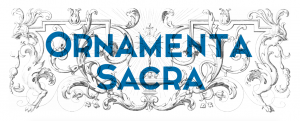 The symposium is dedicated to the iconological and anthropological study of late medieval and early modern liturgical objects (1400-1800), once known as ornamenta sacra. This notion encompasses a wide range of objects made of various materials and techniques (such as chalices, censers and chasubles) which are not only essential for the rites, but also hold a central position in the religious artistic production of the past. Yet, a large portion of recent studies related to the connections between art and liturgy mainly focuses on paintings and sculptures, leaving aside other cult objects. The few studies that take these ritual instruments into account, are primarily devoted to the middle ages. The late middle ages and the early modern period have attracted far less attention, whereas liturgy underwent profound transformations. Although studies limited to certain collections or types of objects are available, we are still in need of a broader analysis instigated by recent methodological trends in historical anthropology and iconology, which have renewed our understanding of images and art objects. We have therefore invited an international group of scholars, experts in their fields and specialized in exactly these methodologies. As a result, the symposium will contribute to this broader analysis and will offer new insights on the material dimension of objects, the place of works of art within a network of relationships, the history of senses and the sensible, and the way in which ornamentation affects meaning.
The symposium is dedicated to the iconological and anthropological study of late medieval and early modern liturgical objects (1400-1800), once known as ornamenta sacra. This notion encompasses a wide range of objects made of various materials and techniques (such as chalices, censers and chasubles) which are not only essential for the rites, but also hold a central position in the religious artistic production of the past. Yet, a large portion of recent studies related to the connections between art and liturgy mainly focuses on paintings and sculptures, leaving aside other cult objects. The few studies that take these ritual instruments into account, are primarily devoted to the middle ages. The late middle ages and the early modern period have attracted far less attention, whereas liturgy underwent profound transformations. Although studies limited to certain collections or types of objects are available, we are still in need of a broader analysis instigated by recent methodological trends in historical anthropology and iconology, which have renewed our understanding of images and art objects. We have therefore invited an international group of scholars, experts in their fields and specialized in exactly these methodologies. As a result, the symposium will contribute to this broader analysis and will offer new insights on the material dimension of objects, the place of works of art within a network of relationships, the history of senses and the sensible, and the way in which ornamentation affects meaning.
For more information and registration, click here.
Art History Seminars • KIK-IRPA • Seminar 20 & Ornasacra Brain Project (UCL • KU Leuven • KIK-IRPA)
